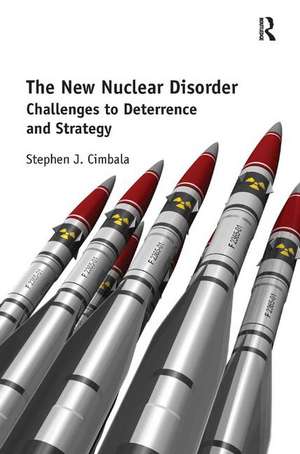The New Nuclear Disorder: Challenges to Deterrence and Strategy
Autor Stephen J. Cimbalaen Limba Engleză Hardback – 28 ian 2015
| Toate formatele și edițiile | Preț | Express |
|---|---|---|
| Paperback (1) | 402.94 lei 6-8 săpt. | |
| Taylor & Francis – 14 aug 2018 | 402.94 lei 6-8 săpt. | |
| Hardback (1) | 1003.93 lei 6-8 săpt. | |
| Taylor & Francis – 28 ian 2015 | 1003.93 lei 6-8 săpt. |
Preț: 1003.93 lei
Preț vechi: 1224.30 lei
-18% Nou
Puncte Express: 1506
Preț estimativ în valută:
192.10€ • 201.08$ • 159.89£
192.10€ • 201.08$ • 159.89£
Carte tipărită la comandă
Livrare economică 31 martie-14 aprilie
Preluare comenzi: 021 569.72.76
Specificații
ISBN-13: 9781472455024
ISBN-10: 1472455029
Pagini: 268
Dimensiuni: 156 x 234 x 23 mm
Greutate: 0.56 kg
Ediția:1
Editura: Taylor & Francis
Colecția Routledge
Locul publicării:Oxford, United Kingdom
ISBN-10: 1472455029
Pagini: 268
Dimensiuni: 156 x 234 x 23 mm
Greutate: 0.56 kg
Ediția:1
Editura: Taylor & Francis
Colecția Routledge
Locul publicării:Oxford, United Kingdom
Notă biografică
Stephen J. Cimbala is Distinguished Professor of Political Science at Penn State Brandywine. Dr Cimbala is an award winning Penn State teacher and the author of numerous works in the fields of national security studies, nuclear arms control and other topics.
Recenzii
’This book should be required reading for all of the military and civilian officials in the Pentagon, members of Congress, and national security analysts who will be involved in deciding whether the Pentagon should spend billions to modernize all three legs of the nuclear triad over the next decade in what Steve Cimbala correctly calls The Second Nuclear Age. Only then will the US government be able to make a sound decision.’ Lawrence J. Korb, Center for American Progress, and former Assistant Secretary of Defense in the Reagan Administration ’Too many people who should know better dismiss nuclear weapons as having no strategic relevance or utility. In this incisive volume, Stephen Cimbala, one of our premier students of all things nuclear and of strategy, demonstrates just how wrong-headed this view is. As long as these weapons are available neither we nor any other government can escape the responsibility of thinking about them strategically. While the strategic environment is a new one, Cimbala convincingly shows that the problems generated by the existence of nuclear weapons may be different than before but they are no less important than during the Cold War.’ Stephen J. Blank, American Foreign Policy Council, USA ’For decades Stephen Cimbala has informed and elevated the discourse on nuclear strategy. In The New Nuclear Disorder he returns to familiar haunts, but offers troubling, paradoxical twists: a world with fewer warheads but more nuclear-armed nations heralds perilous new complexities; mutually agreed arms reductions may actually undermine deterrence; and improvements in missile defenses might spark a fresh new round of arms racing. In short, a sea of troubles looms ahead. Thankfully, Dr Cimbala has crafted outstanding navigational charts to help us find our way.’ John Arquilla, US Naval Postgraduate School, USA
Cuprins
Introduction; Chapter 1 Geography and Nuclear Arms Control; Chapter 2 Anticipatory Attacks and Nuclear Weapons: Challenges to Deterrence and Crisis Stability; Chapter 3 Nuclear Crisis Management in a Digital Age; Chapter 4 Ending a Nuclear War: Deterring and Controlling Escalation; Chapter 5 Cyber War and Nuclear Weapons; Chapter 6 Tsar Wars and Star Wars: Missile Defense, Nuclear Arms Control and Putin; Chapter 7 Nuclear Weapons in Asia: Perils and Promises; Chapter 8 Nuclear Proliferation: Theory and Reality; Chapter 9 Deterrence and Intelligence in Nuclear History: The 1983 'œWar Scare'; Chapter 10 Armed Persuasion and Arms Control: Vladimir Putin in Ukraine, February 21'“March 18, 2014; conclusion Conclusion;
Descriere
In the twenty-first century, the United States confronts an international system of great complexity and shifting security challenges. This book’s relevance lies in its assessment of certain large-looming cases, including the possible acquisition and deployment of nuclear weapons by Iran and the continuing tensions created by North Korea’s nuclear arsenal. The Obama ’pivot’ of national security and defense emphasis to Asia reflects not only the growing economic importance of that region, but also the growing number of security dilemmas in a region that is already awash in nuclear forces. The management of nuclear crises and even the possible need to terminate nuclear wars before they expand beyond a single region are among the possible challenges facing future U.S. and allied policy makers and military leaders.
